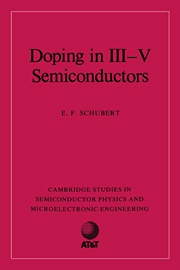Book contents
- Frontmatter
- Contents
- Foreword
- Preface
- List of symbols
- Introduction
- 1 Shallow impurities
- 2 Phenomenology of deep levels
- 3 Semiconductor statistics
- 4 Growth technologies
- 5 Doping with elemental sources
- 6 Gaseous doping sources
- 7 Impurity characteristics
- 8 Redistribution of impurities
- 9 Deep centers
- 10 Doping in heterostructures, quantum wells, and superlattices
- 11 Delta doping
- 12 Characterization techniques
- Appendix A Properties of III–V semiconductors
- Appendix B Constants and conversions
- References
- Index
Introduction
Published online by Cambridge University Press: 05 October 2010
- Frontmatter
- Contents
- Foreword
- Preface
- List of symbols
- Introduction
- 1 Shallow impurities
- 2 Phenomenology of deep levels
- 3 Semiconductor statistics
- 4 Growth technologies
- 5 Doping with elemental sources
- 6 Gaseous doping sources
- 7 Impurity characteristics
- 8 Redistribution of impurities
- 9 Deep centers
- 10 Doping in heterostructures, quantum wells, and superlattices
- 11 Delta doping
- 12 Characterization techniques
- Appendix A Properties of III–V semiconductors
- Appendix B Constants and conversions
- References
- Index
Summary
Impurities are the lifeblood of virtually all semiconductor devices. Impurities determine the semiconductive properties of materials and allow us to vary the conductivity from the semi-insulating via the semi-conductive to the semimetallic range of the conductivity spectrum. The species and concentration of impurities determine the conductivity type and the free carrier concentration of semiconductors. For p-type and n-type impurities the electronic conduction occurs predominantly in the valence and conduction band, respectively. Employment of both conductivity types in one semiconductor makes possible pn-junctions, i.e. rectifying devices. Employment of layered n-p-n-type conductivity allows amplification and switching of electronic signals in transistors. Finally, free carriers must be injected or extracted in all optoelectronic devices. Thus, impurities providing free carriers form the basis of light-emitting diodes, current-injection lasers, photodetectors, and solar cells.
Impurities incorporated into a semiconductor lattice predominantly occupy substitutional lattice sites. In compound semiconductors, the lattice site can be either a cation or an anion site. Which of the two sites is preferred by an impurity depends on a number of factors, including the valence electron correlation between impurity and host, the bond strength between the impurity atom and the surrounding host lattice, and the size of the impurity (strain effects). Examples of impurities incorporated into a III–V semiconductor lattice are schematically shown in Fig. 1. Such compound semiconductors have a zincblende structure, in which cations and anions are bonded with tetrahedral symmetry.
- Type
- Chapter
- Information
- Doping in III-V Semiconductors , pp. 1 - 5Publisher: Cambridge University PressPrint publication year: 1993

